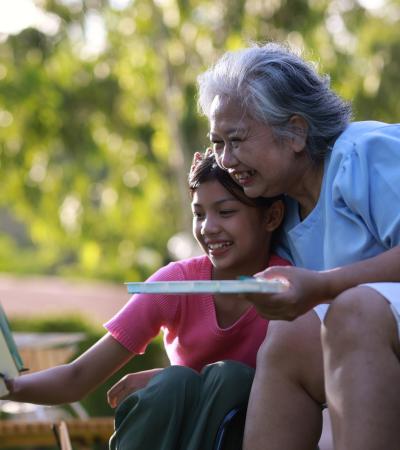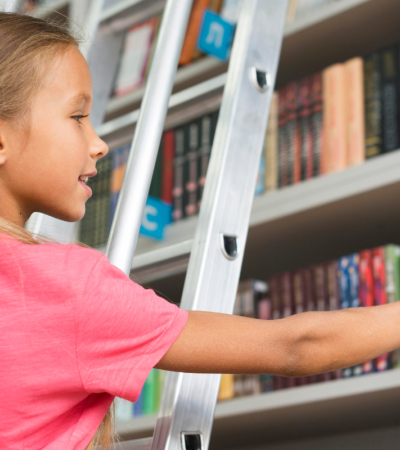Kindergarten Gear Up is a research-based, ten-session school readiness program developed by San Diego County Library and reviewed by experts from San Diego State University, the Bay Area Discovery Museum and Equity Matters Northwest.
Designed for both children and caregivers, the program prepares families for kindergarten and is accessible through a comprehensive website funded by the California State Library. Libraries in states including Virginia, Michigan, Maryland, and California have successfully implemented the program using the freely available curriculum and resources.
Advanced Planning
Since its launch in 2014, the primary mission of Kindergarten Gear Up has been to close the opportunity gap in access to school readiness experiences for children entering kindergarten. At the time of the program's inception, nearly 30% of children in California entered kindergarten without having attended preschool or participated in a structured early learning experience.
Kindergarten Gear Up recognizes that school readiness is far more than early literacy—it encompasses the development of independence, social-emotional skills, group engagement, and a strong sense of community for both children and their caregivers.
During the COVID-19 pandemic, when in-person programming came to a halt, San Diego County Library pivoted quickly. With support from the California State Library, a comprehensive online platform was developed to house all Kindergarten Gear Up resources, including curriculum guides, lesson plans, activity suggestions, promotional materials and curated booklists.
This curriculum was created and refined through collaboration with respected experts and institutions, including early learning professionals, the Department of Education at San Diego State University, and the Bay Area Discovery Museum. Equity Matters Northwest provided essential guidance on diversity, equity, and inclusion, ensuring the content was reflective and supportive of all families. Librarians and library staff across the county contributed to the program’s success by leading sessions, developing interactive learning experiences, and selecting diverse, culturally relevant literature.
The result is a research-based, scalable school readiness program that can be readily adopted by other library systems—an innovative, community-focused model that equips children with the foundational skills they need to thrive in school and beyond.
Marketing
Kindergarten Gear Up has seen strong community engagement, with promotion through branch social media, storytimes, and outreach at neighboring libraries. Registration is managed to maintain an effective ratio—typically one adult per 12 children—resulting in intimate, high-impact sessions that often reach full capacity by the first class, with around 20 children and 20 caregivers participating per session.
Designed specifically for public library staff, the program’s accessible website and ready-to-use content have been widely shared at both in-person and virtual library conferences, including the California Library Association (CLA) 2018 Conference, the Serra Youth Services Virtual Conference in 2021, the California Youth Services Interest Group Summit in 2024, and the Public Library Association (PLA) 2024 Virtual Conference.
As a result of this outreach—particularly the PLA 2024 session—the program has successfully expanded beyond California, with libraries in Virginia, Maryland, and Michigan now adopting the Kindergarten Gear Up model to support families and strengthen school readiness in their communities.
Budgeting
Kindergarten Gear Up is designed to be highly cost-effective, with minimal to no financial burden on hosting libraries. Developed specifically for public librarians, the program utilizes materials commonly found in library branches and incorporates widely available, popular book titles. The website includes a filterable activities section that highlights no-cost options aligned with each session’s themes. With its flexible structure, the program can be successfully implemented on any budget—including at zero cost.
The construction of the website, curriculum reviews, video and audio clips cost $120,000.00 and was funded by the California State Library.
Day-of-event Activity
Program setup is adaptable based on the library’s layout, but it is essential to designate two distinct yet proximate spaces: one for children to engage in interactive activities with library staff, and another for caregivers to participate in peer discussions and connect with community experts such as school administrators, nutritionists, and emergency service representatives.
The spatial arrangement should support both active engagement and a comfortable environment for open conversation, while maintaining clear sightlines and accessibility between the two areas.
Staffing needs vary by session size, but typically require a minimum of two to three staff members—one to lead the children's activities, one to facilitate the caregiver discussion space, and additional support staff as needed for setup and logistical coordination.
Program Execution
Caregivers and their child(ren) arrive approximately 5-10 minutes before the one-hour session begins. The sessions begin with circle time including the caregiver. At the conclusion of circle time, caregivers say goodbye to their child(ren) and remove themselves to participate in the caregiver portion while children remain engaged in activities, songs and storytime. After approximately 20-30 minutes caregivers return, and they participate in an activity with their child. Children are encouraged to share what they did during the session, and we end with cleaning up and a goodbye song.
Each session can hold up to 24 children and 24 caregivers, however most of our programs are fewer than 15 children and 15 caregivers.
By the end of the 10 sessions, most children understand group dynamics, how to get in a line, take turns and identify the alphabet and numbers. Most caregivers have met other caregivers and have been connected with experts and resources in their community that will support their family's transition into kindergarten.
Advice
- Limit enrollment to under 20 children per session, this is meant to simulate a kindergarten experience and most classrooms do not allow more than 20 students. Also, by limiting the number of participants, activities, discussions, and songs can be more enriching in small groups.
- Also always have two adults in the children's portion of the program. If a child needs their adult for any reason, the other adult will walk them to their adult.
- Plan lessons ahead of time.
- Coordinate community experts first to align lesson plans to their schedule.



